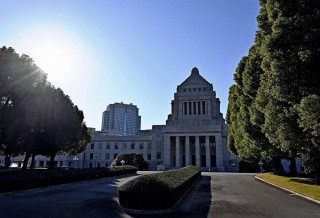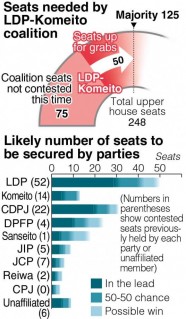Loading
Search
▼ LDP-Komeito Coalition Could Lose Upper House Majority; Single-Seat Constituencies Seen as Deciding Factor
- Category:Event
The ruling Liberal Democratic Party may be able to secure only around 40 seats in the upcoming House of Councillors election as its candidates are struggling in prefectural constituencies, making it uncertain whether the ruling coalition of the LDP and Komeito will be able to maintain their upper house majority, according to an analysis by The Yomiuri Shimbun.
The analysis is based on a survey conducted both by telephone and online on Thursday and Friday, taking into consideration coverage by reporters at the Yomiuri’s regional bureaus across the country.
The most attention is focused on whether the ruling coalition can secure at least 50 seats, thereby keeping their majority in the upper house.
Results in prefectural constituencies where only one seat is up for grabs are expected to affect the overall election result. Among those constituencies, the LDP is in the lead in constituencies with solid conservative foundations, such as Ishikawa, Fukui and Yamaguchi. But the party’s candidates are lagging those associated with opposition parties in the Tohoku region, Shikoku and Kyushu.
The analysis is based on a survey conducted both by telephone and online on Thursday and Friday, taking into consideration coverage by reporters at the Yomiuri’s regional bureaus across the country.
The most attention is focused on whether the ruling coalition can secure at least 50 seats, thereby keeping their majority in the upper house.
Results in prefectural constituencies where only one seat is up for grabs are expected to affect the overall election result. Among those constituencies, the LDP is in the lead in constituencies with solid conservative foundations, such as Ishikawa, Fukui and Yamaguchi. But the party’s candidates are lagging those associated with opposition parties in the Tohoku region, Shikoku and Kyushu.
In constituencies where multiple seats are contested, the party may be able to win one seat each in those where two seats are up for grabs, including Ibaraki and Shizuoka. But the race is close in constituencies where three or more seats are contested as multiple candidates have a 50-50 chance of winning.
The situation for Komeito is also highly unpredictable. In constituencies where multiple seats are up for grabs, its candidates are running close races in Saitama, Kanagawa, Osaka and Hyogo. As the party is also struggling with the proportional representation segment, Komeito may lose some of the contested seats it previously held.
In contrast, the main opposition Constitutional Democratic Party of Japan is faring well. It is in the lead in several prefectural constituencies where one seat is contested, including Nagano, Mie and Oita. It is also one of the top parties in constituencies where multiple seats are up for grabs, including Hokkaido, Saitama, Chiba and Kanagawa.
The CDPJ is also doing solidly in the proportional representation segment, likely winning as many as seven seats, the same number it won in the previous upper house election.
The Democratic Party for the People is running ahead in the prefectural constituency in Kagawa, from which its leader Yuichiro Tamaki was elected.
It is also leading over other parties in the Shizuoka and Aichi constituencies, where multiple seats are up for grabs. As the party is faring well in the proportional representation segment, it may be able to win double the number of seats it had before the election.
Sanseito may be able to secure a seat in the Tokyo constituency and win multiple seats in the proportional representation segment, possibly making a huge advance.
The Japan Innovation Party, the Japanese Communist Party and Reiwa Shinsengumi are fighting for seats in constituencies where multiple seats are up for grabs. The Conservative Party of Japan is likely to win its first upper house seat in the proportional representation segment.
In the upcoming upper house election, 125 of 248 seats are up for grabs. A total of 522 people filed their candidacies — 350 for 75 constituency seats and 172 for the proportional representation segment.
The phone and online survey received responses from 140,537 people. As a certain number of respondents did not give the names of candidates or parties they plan to vote for, the situation still remains fluid.
The situation for Komeito is also highly unpredictable. In constituencies where multiple seats are up for grabs, its candidates are running close races in Saitama, Kanagawa, Osaka and Hyogo. As the party is also struggling with the proportional representation segment, Komeito may lose some of the contested seats it previously held.
In contrast, the main opposition Constitutional Democratic Party of Japan is faring well. It is in the lead in several prefectural constituencies where one seat is contested, including Nagano, Mie and Oita. It is also one of the top parties in constituencies where multiple seats are up for grabs, including Hokkaido, Saitama, Chiba and Kanagawa.
The CDPJ is also doing solidly in the proportional representation segment, likely winning as many as seven seats, the same number it won in the previous upper house election.
The Democratic Party for the People is running ahead in the prefectural constituency in Kagawa, from which its leader Yuichiro Tamaki was elected.
It is also leading over other parties in the Shizuoka and Aichi constituencies, where multiple seats are up for grabs. As the party is faring well in the proportional representation segment, it may be able to win double the number of seats it had before the election.
Sanseito may be able to secure a seat in the Tokyo constituency and win multiple seats in the proportional representation segment, possibly making a huge advance.
The Japan Innovation Party, the Japanese Communist Party and Reiwa Shinsengumi are fighting for seats in constituencies where multiple seats are up for grabs. The Conservative Party of Japan is likely to win its first upper house seat in the proportional representation segment.
In the upcoming upper house election, 125 of 248 seats are up for grabs. A total of 522 people filed their candidacies — 350 for 75 constituency seats and 172 for the proportional representation segment.
The phone and online survey received responses from 140,537 people. As a certain number of respondents did not give the names of candidates or parties they plan to vote for, the situation still remains fluid.
- July 5, 2025
- Comment (0)
- Trackback(0)



